Delos Archaeological Site & Museum
Despite its diminutive size, Delos is one of the most important archaeological sites in Greece, and certainly the most important in the Cyclades. Delos was a place of such importance that the surrounding islands were known as the Cyclades, since it was thought that they lay in a circle round the island on which the Apollo-Sun, god of day light and Artemis-Moon, goddess of night light were born. The special importance of Delos is emphasized by the fact that, geographically, it lies on the straight line on which also Dodona, Delphi and the Acropolis Parthenon are!
Please bookmark this page and do come back from time to time, to see it growing. Thank you!
Select Page of the Album:
Click on any of the pictures to enlarge.
Delos Archaeological Museum Mosaic CollectionMosaic Techniques The floors of the temples and of public buildings were usually covered with expensive marble slabs, while markets, squares and roads are often covered with slabs of gneiss. The houses have floors of beaten earth or mosaic but it is very possible that there were also wooden floors. The mosaic floors, a kind of permanent carpets, are impressive, lasting and very practical, since they could easily be washed, consequently they were very trendy among the wealthy house-owners of the period. For the construction of the mosaic floors a variety of materials were used (stones, glass, parts of wine Jars) broken in segments (opus segmentatum), cut in cubes (opus tessellatum), or cut in the required shapes (opus vermiculatum).The design was incised on the wet mortar with the help of lead stencils. A narrow strip of lead used as a boundary for the partial motifs enhances the clarity of the overall design. Simple mosaics were done on the spot but the central panels (emblema), which required more time and patience, were executed in the workshop, on a bed of lighter mortar, and were transportable. It seems that there was a specific repertoire from which the customer would choose, for the same themes occur again and again not only in Delos but in many other towns of the Hellenistic period. The mosaics of Delos date from the last decades of 2nd century B.C. to the first decades of 1st century B.C. Source ©: John S. Latsis Public Benefit Foundation
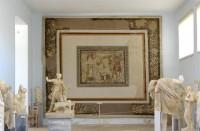
Delos Archaeological Museum: Mosaic floor from a house on the hill
The vegetal motifs, guilloches and vine branches with leaves and grapes, are rendered in a strikingly naturalistic manner with bull heads and masks of the New Comedy characters. |
|
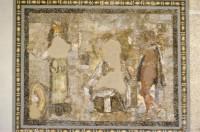
Delos Archaeological Museum: Mosaic floor from a house on the hill
The central design of this mosaic floor depicts three figures - Athena in armor and helmet, Hermes in chlamys and petasos, and a majestic seated figure that cannot be identified due to damage. |
|
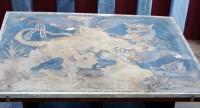
Delos Archaeological Museum: Mosaic floor from the House of Dionysus
The famous central decoration of the mosaic pavement in the central court of the House of Dionysus (Theater Quarter). This house has been named after the main figure depicted in the mosaic work, namely Dionysus, riding a panther. God Dionysus, with with outstretched wings and an ivy wreath, is mounted on a panther with a wreath of vine branches and grapes around its neck. In his right hand the god grasps the beribboned thyrsos as if it was a spear. On the ground, between plants, a kantharos, a wine vessel; thyrsos, vine, ivy (since Homeric times called Dionysion), kantharos, all are attributes of the god of wine. |
|
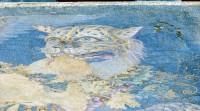
Delos Archaeological Museum: Mosaic floor from the House of Dionysus
Detail from the mosaic of Dionysus riding a Panther: the head of the panther and the decoration around its neck. |
|
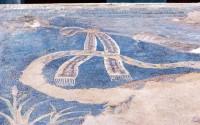
Delos Archaeological Museum: Mosaic floor from the House of Dionysus
Detail from the mosaic of Dionysus riding a Panther: the thyrsos, emblem of the god, and the panther's tail. |
|
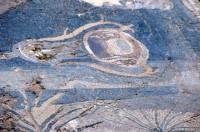
Delos Archaeological Museum: Mosaic floor from the House of Dionysus
Detail from the mosaic of Dionysus riding a Panther: the silver kantharos, wine vessel, overturned on the floor. |
|
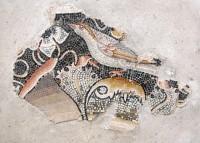
Delos Archaeological Museum: Bird Mosaic, probably a partridge |
|
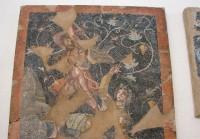
Delos Archaeological Museum: Daphne and Apollo Mosaic |
|
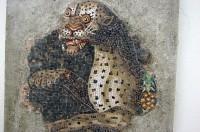
Delos Archaeological Museum: Mosaic Panther and Grapes |
|
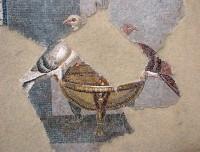
Delos Archaeological Museum: Mosaic with Pigeons at a Watering Container |
|
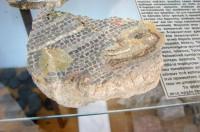
Delos Archaeological Museum: Mosaic fragment |
|
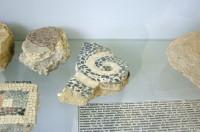
Delos Archaeological Museum: Mosaic fragment |
|
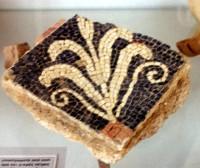
Delos Museum: Mosaic Corner Decorative Pattern |
|
|
Select Page of the Album:
|
|



